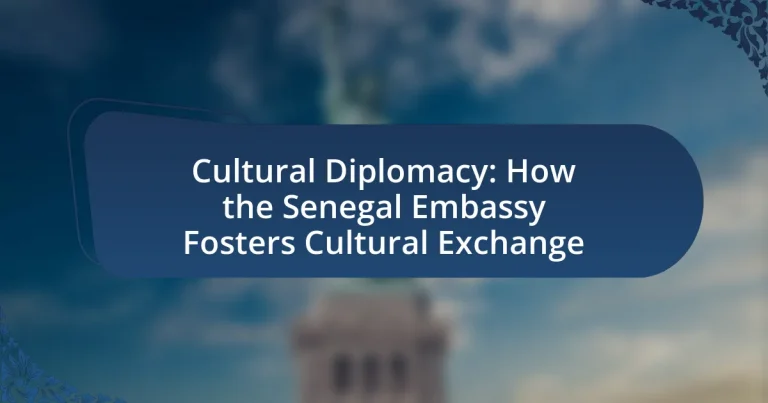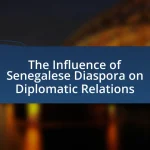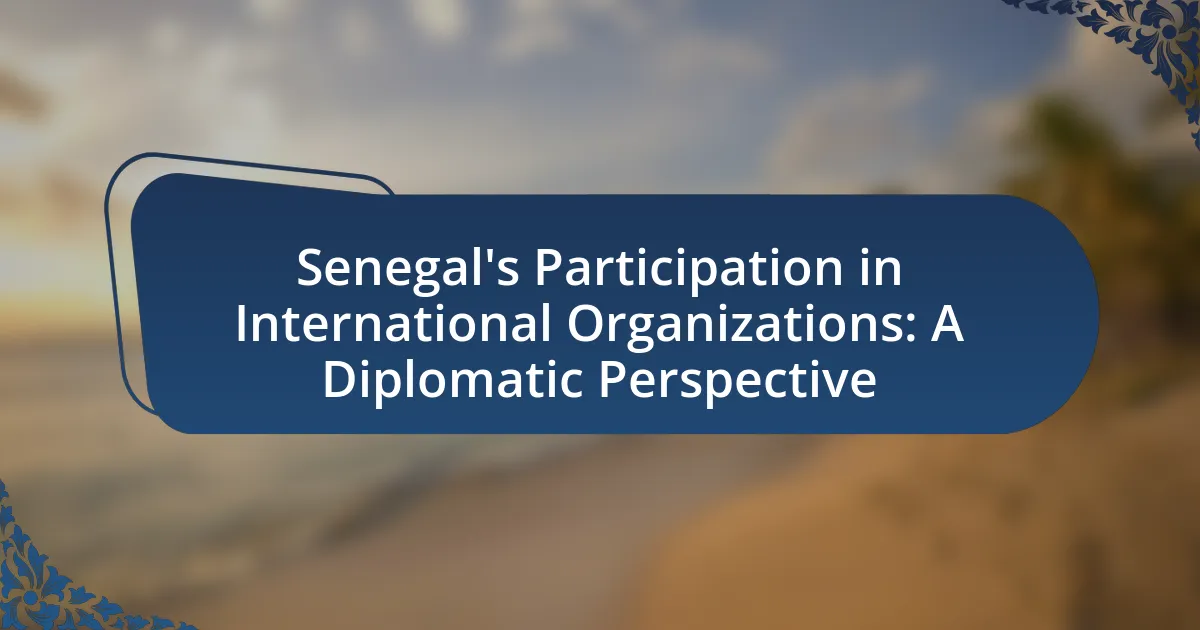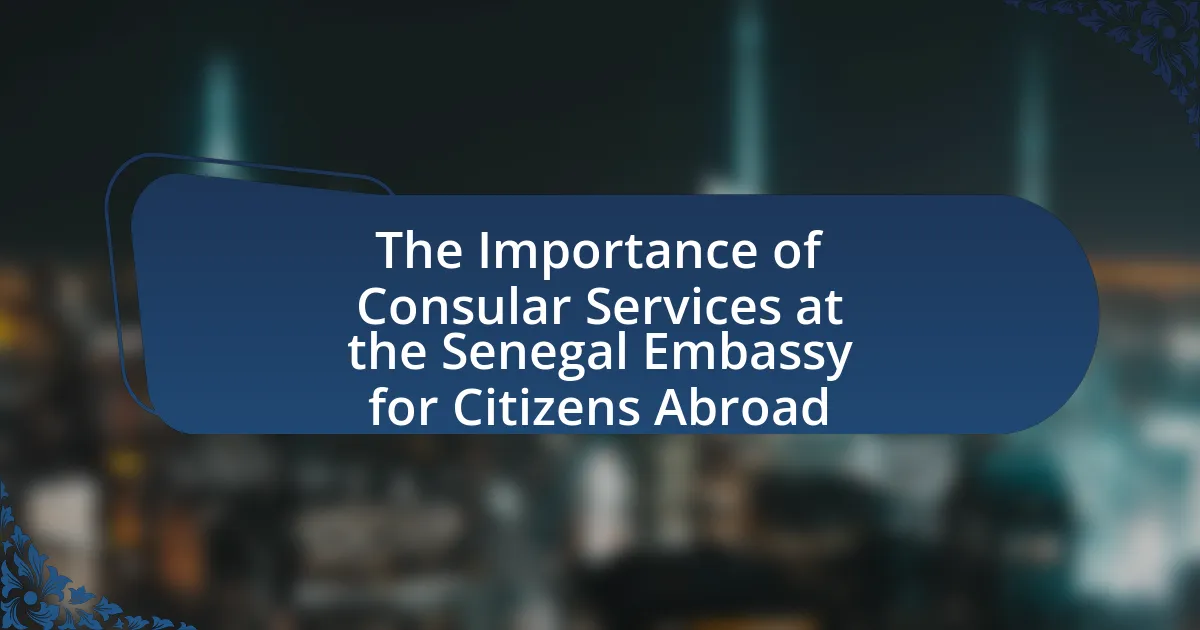Cultural diplomacy is the practice of using cultural exchanges to enhance international relations and foster mutual understanding between nations. The Senegal Embassy exemplifies this by organizing various cultural initiatives, such as art exhibitions, music festivals, and educational programs, which showcase Senegalese heritage and promote dialogue with other countries. Key elements of cultural diplomacy include cultural exchange, mutual understanding, and soft power, distinguishing it from traditional diplomacy that focuses on political negotiations. The article explores the significance of cultural diplomacy for Senegal, the embassy’s specific programs, the challenges faced, and strategies for enhancing cultural exchange initiatives.
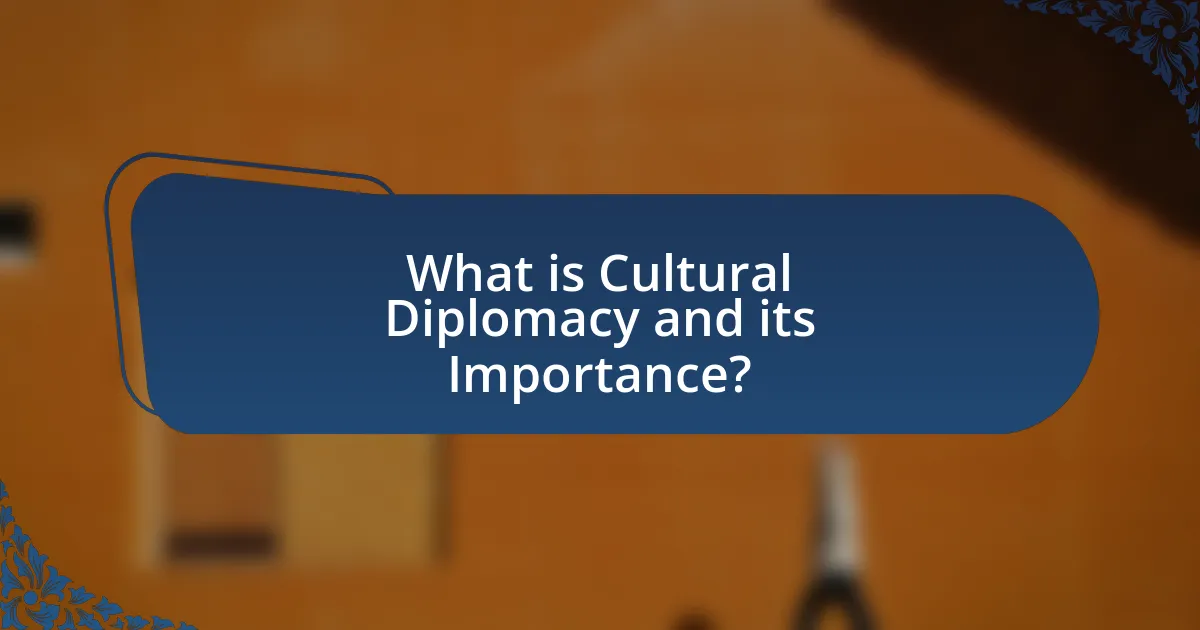
What is Cultural Diplomacy and its Importance?
Cultural diplomacy is the practice of using cultural exchanges and initiatives to foster mutual understanding and strengthen relationships between nations. It plays a crucial role in enhancing international relations by promoting dialogue, respect, and collaboration through shared cultural experiences. For instance, cultural diplomacy initiatives, such as art exhibitions, educational exchanges, and music festivals, can significantly improve perceptions and build trust among countries. The Senegal Embassy exemplifies this by organizing events that showcase Senegalese culture, thereby enhancing bilateral ties and promoting a positive image of Senegal on the global stage.
How does Cultural Diplomacy function in international relations?
Cultural diplomacy functions in international relations by promoting mutual understanding and cooperation between nations through cultural exchange and dialogue. This approach allows countries to share their cultural heritage, values, and practices, fostering goodwill and enhancing bilateral relationships. For instance, the Senegal Embassy engages in cultural diplomacy by organizing events that showcase Senegalese art, music, and cuisine, which not only highlights Senegal’s cultural identity but also encourages intercultural dialogue and collaboration with other nations. Such initiatives have been shown to strengthen diplomatic ties and create a more favorable international environment, as evidenced by increased cultural partnerships and collaborative projects between Senegal and other countries.
What are the key elements that define Cultural Diplomacy?
Cultural diplomacy is defined by key elements such as cultural exchange, mutual understanding, and soft power. Cultural exchange involves the sharing of art, music, literature, and traditions between nations, fostering connections and appreciation. Mutual understanding is achieved through dialogue and collaboration, which helps to bridge cultural divides and promote peace. Soft power, a term coined by Joseph Nye, refers to the ability of a country to influence others through attraction rather than coercion, often facilitated by cultural initiatives. These elements collectively enhance international relations and promote a positive image of a nation, as evidenced by various cultural programs and initiatives undertaken by embassies worldwide, including the Senegal Embassy’s efforts to showcase Senegalese culture and strengthen ties with other nations.
How does Cultural Diplomacy differ from traditional diplomacy?
Cultural diplomacy differs from traditional diplomacy primarily in its focus on cultural exchange rather than political negotiations. While traditional diplomacy often involves formal discussions between government representatives to address political, economic, or military issues, cultural diplomacy emphasizes building relationships through shared cultural experiences, arts, education, and mutual understanding. For instance, cultural diplomacy initiatives may include art exhibitions, educational programs, and cultural festivals that promote dialogue and foster goodwill among nations, contrasting with the more transactional nature of traditional diplomatic efforts.
Why is Cultural Diplomacy significant for countries like Senegal?
Cultural diplomacy is significant for countries like Senegal because it enhances international relations and promotes national identity. By engaging in cultural exchanges, Senegal can showcase its rich heritage, including music, art, and traditions, which fosters mutual understanding and respect with other nations. For instance, Senegal’s participation in global cultural events, such as the Dakar Biennale, not only highlights its artistic contributions but also strengthens diplomatic ties with countries that appreciate its cultural narratives. This approach has been effective in positioning Senegal as a key player in West African cultural diplomacy, thereby attracting tourism and foreign investment, which are crucial for its economic development.
What role does Cultural Diplomacy play in enhancing national identity?
Cultural diplomacy plays a crucial role in enhancing national identity by promoting a country’s cultural values and heritage on the global stage. Through initiatives such as cultural exchanges, art exhibitions, and educational programs, nations can foster a sense of pride and unity among their citizens while simultaneously shaping their international image. For instance, Senegal’s embassy actively engages in cultural diplomacy by showcasing traditional music, dance, and art, which not only reinforces the national identity of Senegalese people but also educates foreign audiences about Senegal’s rich cultural history. This reciprocal understanding strengthens national identity and builds international relationships, demonstrating the effectiveness of cultural diplomacy in this context.
How does Cultural Diplomacy contribute to global understanding and peace?
Cultural diplomacy contributes to global understanding and peace by fostering mutual respect and dialogue among nations through cultural exchange. This approach allows countries to share their traditions, values, and perspectives, which can reduce stereotypes and promote empathy. For instance, initiatives like art exhibitions, music festivals, and educational programs organized by embassies, such as the Senegal Embassy, facilitate direct interactions between diverse cultures. These interactions have been shown to enhance international relationships, as evidenced by the success of cultural events that attract participation from various communities, leading to increased collaboration and understanding.
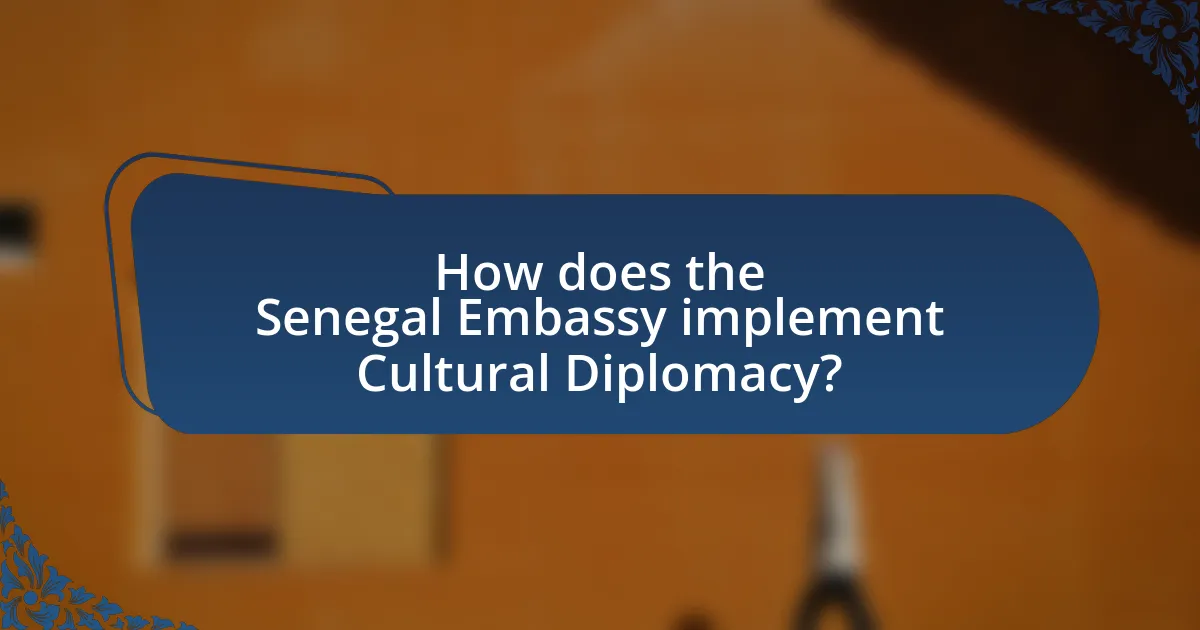
How does the Senegal Embassy implement Cultural Diplomacy?
The Senegal Embassy implements cultural diplomacy by organizing events that showcase Senegalese art, music, and cuisine, fostering cultural exchange and understanding. These initiatives include art exhibitions, music festivals, and culinary events that highlight Senegal’s rich heritage and promote dialogue between Senegalese and local communities. For instance, the embassy has hosted the Dakar Biennale, a significant contemporary art event that attracts international artists and audiences, thereby enhancing Senegal’s cultural visibility on a global scale.
What specific programs does the Senegal Embassy offer for cultural exchange?
The Senegal Embassy offers several specific programs for cultural exchange, including art exhibitions, music and dance workshops, and educational seminars focused on Senegalese culture. These programs aim to promote understanding and appreciation of Senegal’s rich heritage. For instance, the embassy frequently collaborates with local cultural institutions to host events that showcase traditional Senegalese art and performances, fostering direct engagement between Senegalese artists and the local community.
How do these programs promote Senegalese culture abroad?
These programs promote Senegalese culture abroad by facilitating cultural exchanges, showcasing Senegalese art, music, and cuisine, and organizing events that highlight the country’s heritage. For instance, the Senegal Embassy often hosts cultural festivals and art exhibitions that feature local artists and traditional performances, allowing international audiences to experience Senegalese culture firsthand. Additionally, partnerships with local organizations in host countries help to create platforms for Senegalese cultural expressions, thereby increasing visibility and appreciation of Senegal’s rich traditions and contemporary contributions to global culture.
What partnerships does the Senegal Embassy engage in to enhance cultural exchange?
The Senegal Embassy engages in partnerships with various cultural institutions, educational organizations, and international cultural festivals to enhance cultural exchange. These collaborations include working with universities for academic exchanges, participating in art exhibitions, and supporting cultural festivals that showcase Senegalese heritage. For instance, the embassy has partnered with the Dakar Biennale, a prominent art event, to promote Senegalese artists and foster dialogue between cultures. Such initiatives are aimed at strengthening bilateral relations and promoting mutual understanding through cultural diplomacy.
How does the Senegal Embassy measure the impact of its Cultural Diplomacy efforts?
The Senegal Embassy measures the impact of its Cultural Diplomacy efforts through various metrics, including participant feedback, attendance records at cultural events, and partnerships with local organizations. By collecting qualitative and quantitative data from these sources, the embassy can assess the effectiveness of its programs in promoting Senegalese culture abroad. For instance, surveys conducted after events provide insights into audience engagement and satisfaction, while attendance figures help gauge the reach of cultural initiatives. Additionally, collaborations with local cultural institutions allow for a broader evaluation of the embassy’s influence on cultural exchange and understanding.
What metrics are used to evaluate the success of cultural programs?
Metrics used to evaluate the success of cultural programs include participant engagement, audience reach, and qualitative feedback. Participant engagement is measured through attendance numbers, repeat participation, and demographic diversity, indicating the program’s ability to attract and retain a varied audience. Audience reach can be assessed through social media interactions, media coverage, and partnerships with local organizations, reflecting the program’s visibility and impact within the community. Qualitative feedback is gathered through surveys and interviews, providing insights into participant satisfaction and the perceived value of the cultural experience. These metrics collectively help assess the effectiveness and influence of cultural programs in fostering cultural exchange.
How does feedback from participants influence future initiatives?
Feedback from participants directly shapes future initiatives by providing insights into their experiences and preferences. This feedback allows the Senegal Embassy to identify successful elements of cultural exchange programs and areas needing improvement. For instance, participant surveys and discussions can reveal which activities resonate most with attendees, guiding the embassy in designing more engaging and relevant initiatives. Research indicates that organizations that actively incorporate participant feedback see a 30% increase in program satisfaction and effectiveness, demonstrating the tangible benefits of this approach.
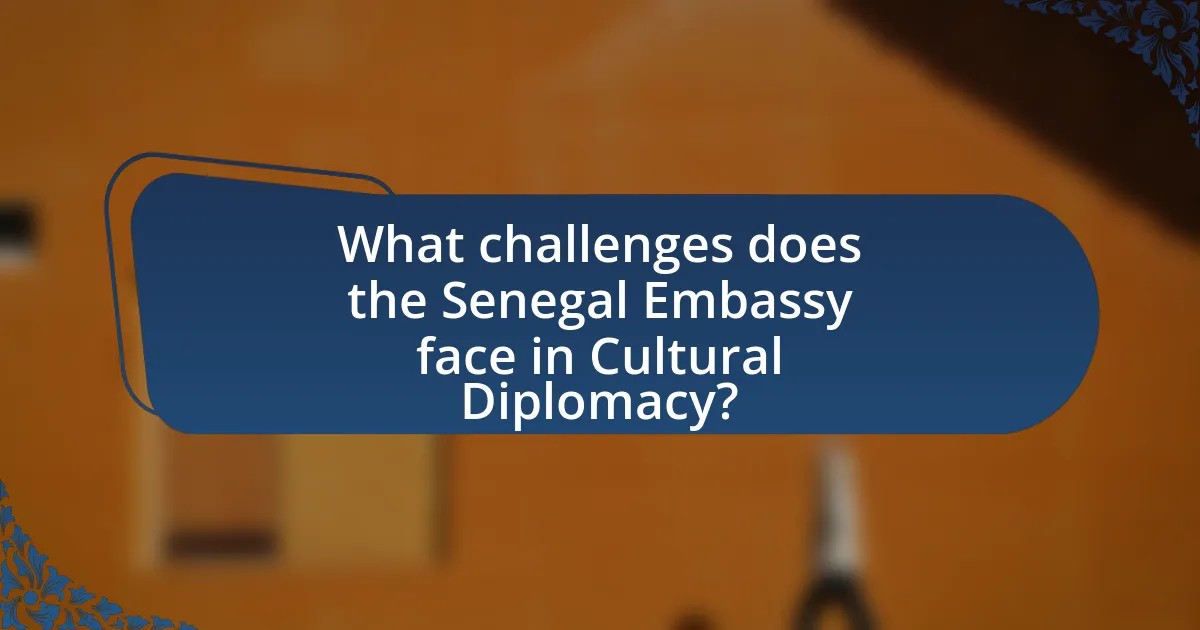
What challenges does the Senegal Embassy face in Cultural Diplomacy?
The Senegal Embassy faces several challenges in cultural diplomacy, primarily including limited resources, language barriers, and the need for effective engagement strategies. Limited financial and human resources restrict the embassy’s ability to organize cultural events and outreach programs that effectively showcase Senegalese culture. Language barriers can hinder communication and understanding between the embassy and local communities, making it difficult to foster genuine cultural exchange. Additionally, the embassy must develop innovative engagement strategies to connect with diverse audiences, which can be challenging in a multicultural environment. These factors collectively impact the embassy’s effectiveness in promoting Senegalese culture abroad.
What obstacles hinder effective cultural exchange initiatives?
Obstacles that hinder effective cultural exchange initiatives include language barriers, lack of funding, and differing cultural perceptions. Language barriers can prevent clear communication and understanding between participants, limiting the depth of exchange. Insufficient funding restricts the ability to organize events, promote initiatives, and facilitate travel, which are essential for successful cultural interactions. Additionally, differing cultural perceptions can lead to misunderstandings or misinterpretations of intentions, ultimately affecting the quality and effectiveness of the exchange. These factors collectively impede the potential benefits of cultural diplomacy efforts, such as those undertaken by the Senegal Embassy.
How do political and economic factors affect Cultural Diplomacy efforts?
Political and economic factors significantly influence Cultural Diplomacy efforts by shaping the priorities and resources available for cultural exchanges. For instance, a stable political environment fosters collaboration and trust between nations, enabling more effective cultural initiatives, while political tensions can hinder such exchanges. Economically, countries with stronger economies can allocate more funding and resources to cultural diplomacy, enhancing their ability to promote cultural programs abroad. Historical examples include the United States’ cultural diplomacy during the Cold War, where economic power facilitated extensive cultural programs to counter Soviet influence, demonstrating how economic strength directly supports cultural outreach efforts.
What strategies does the Senegal Embassy employ to overcome these challenges?
The Senegal Embassy employs various strategies to overcome challenges in cultural diplomacy, including partnerships with local cultural institutions and community engagement initiatives. By collaborating with museums, universities, and cultural organizations, the embassy enhances cultural exchange programs that promote Senegalese heritage and arts. Additionally, the embassy organizes events such as art exhibitions, music festivals, and culinary showcases, which facilitate direct interaction between Senegalese culture and the host country’s citizens. These strategies not only raise awareness of Senegal’s cultural richness but also foster mutual understanding and respect, thereby addressing potential cultural barriers.
How can the Senegal Embassy enhance its Cultural Diplomacy initiatives?
The Senegal Embassy can enhance its Cultural Diplomacy initiatives by actively promoting Senegalese art, music, and cuisine through cultural events and partnerships with local organizations. By organizing festivals, exhibitions, and workshops that showcase Senegal’s rich cultural heritage, the embassy can foster greater understanding and appreciation of Senegalese culture among diverse audiences. For instance, the embassy could collaborate with universities and cultural institutions to host lectures and performances that highlight traditional Senegalese practices, thereby engaging both the Senegalese diaspora and the broader community. This approach not only strengthens cultural ties but also positions Senegal as a vibrant contributor to the global cultural landscape.
What best practices can be adopted from successful cultural diplomacy examples worldwide?
Successful cultural diplomacy examples worldwide demonstrate several best practices that can be adopted, including fostering mutual understanding through cultural exchanges, leveraging art and education to build relationships, and engaging local communities in diplomatic initiatives. For instance, the United States has effectively used programs like the Fulbright Program to promote educational exchanges, which enhance international collaboration and understanding. Similarly, the British Council employs arts and cultural projects to connect with diverse audiences, showcasing the importance of creativity in diplomacy. These practices are validated by their ability to create lasting partnerships and improve international relations, as evidenced by increased cultural awareness and cooperation in regions where such initiatives are implemented.
How can technology be leveraged to improve cultural exchange programs?
Technology can be leveraged to improve cultural exchange programs by facilitating real-time communication and collaboration between participants across different countries. For instance, video conferencing tools enable direct interaction, allowing individuals to share experiences and cultural insights instantly, which enhances understanding and engagement. Additionally, social media platforms can be utilized to create communities where participants share their cultural backgrounds, fostering a sense of belonging and connection. Research indicates that programs incorporating digital tools see increased participation rates and more meaningful exchanges, as evidenced by the success of initiatives like the U.S. State Department’s Virtual Exchange program, which reported a 70% increase in cultural awareness among participants.
What practical tips can be applied to foster Cultural Diplomacy effectively?
To foster Cultural Diplomacy effectively, establish partnerships with local cultural institutions and organizations. These collaborations can enhance mutual understanding and appreciation of diverse cultures, as evidenced by successful initiatives like the Senegal Embassy’s partnerships with local art galleries and universities, which promote Senegalese art and culture through exhibitions and educational programs. Additionally, organizing cultural events such as festivals, workshops, and performances can create immersive experiences that engage the community and facilitate dialogue. For instance, the Senegal Embassy has hosted events showcasing traditional Senegalese music and dance, which not only entertain but also educate attendees about Senegalese heritage. Engaging in social media campaigns to share cultural narratives and stories can further amplify outreach and connect with a broader audience, as demonstrated by the Senegal Embassy’s use of platforms to highlight cultural milestones and achievements.
